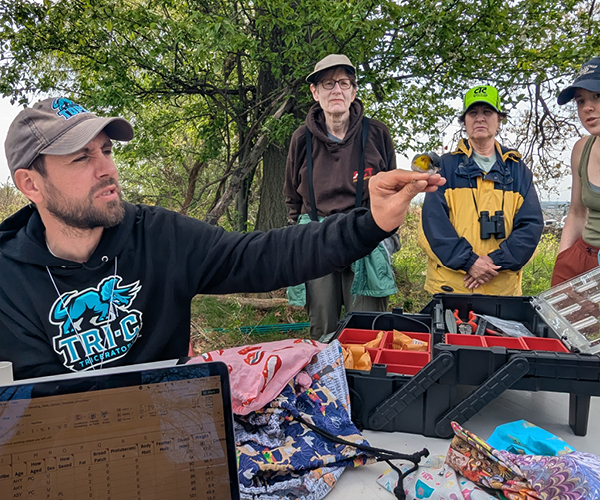Eastern Campus Faculty Take Flight With Bird Banding Project
Faculty Innovation Grant gives wings to unique student learning experience
 HIGHLAND HILLS — The Eastern Campus of Cuyahoga Community College (Tri-C®) is now home to a groundbreaking bird research and teaching initiative, thanks to a collaborative project supported by the College's Faculty Innovation Grant.
HIGHLAND HILLS — The Eastern Campus of Cuyahoga Community College (Tri-C®) is now home to a groundbreaking bird research and teaching initiative, thanks to a collaborative project supported by the College's Faculty Innovation Grant.
Biology Professor Sean Williams, Plant Science and Landscape Technology (PST) Assistant Professor Jim Funai and Program Director Lori Zatroch worked together to create a cross-disciplinary project. It has already made a lasting impact on student engagement and experiential learning.
The study aims to establish whether it's possible to study birds in a forest canopy, adding a research dimension to the teaching project. In the future, the team hopes to investigate whether the capture rates of different bird species, ages and physiologies vary between the ground and canopy.
"This wasn't just about birds," Williams said. "It was about showing students what's possible when you merge passion, curiosity and hands-on learning. This is what community college science education can, and should, look like."
The grant enabled the trio to launch a mist netting and songbird banding station at the Eastern Campus — an ideal location because its habitat is a mix of fields and forests, and the higher elevation is attractive to migratory birds.
Williams, a federally certified bird bander through the U.S. Geological Survey (USGS) Bird Banding Laboratory, used the funding to purchase and install 10 mist nets and a full suite of bird banding equipment. Since 2022, Williams has identified more than 150 bird species at the Eastern Campus — some of which are rare for Cuyahoga County.
"This is one of the few places in our region where students can directly engage in field biology of this kind," Williams said. "It's more than just science. It's a transformative experience. Students aren't just reading about migration or population ecology. They're holding the data in their hands — literally."
Mist netting is a scientific method used to safely and briefly capture wild songbirds. Birds in the hand are measured, fitted with a uniquely numbered leg band issued by the USGS and released. The process supports critical research on bird migration, population dynamics, physiology and behavior.
The project was embedded into three of Williams' courses: Human Biology Lab (BIO-105L), Principles of Biology II (BIO-1510) and Ornithology (BIO-1815). Students helped deploy nets, observe bird capture and banding procedures and learn to analyze ecological data. Williams said the student response was overwhelmingly positive, with many citing the bird banding lab as their favorite part of the semester. Some students were inspired to volunteer with their local bird banding station.
Meanwhile, the project's success hinged on the support of Funai and Zatroch from the PST program. Their expertise was crucial in installing some of the mist nets in the forest canopy. Funai, an expert arborist, led the design and rigging of elevated net systems using steel strut channels, which were tested in various tree settings near the southern end of campus forest.
"Our students got to see how ecological research requires both scientific knowledge and technical problem-solving," said Zatroch. "This was a real-world application of arboriculture, engineering and biology coming together to solve a complex challenge."
August 22, 2025
MEDIA CONTACT: Anthony Moujaes, 216-987-3068 or anthony.moujaes@tri-c.edu
